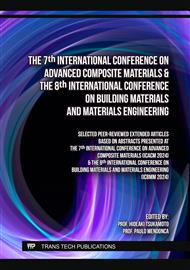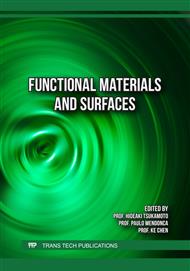[1]
Makul, N., Principles of Low-Carbon Cement. 2021, Springer International Publishing AG: Switzerland. pp.43-77.
Google Scholar
[2]
Oguntona, O.A. and C.O. Aigbavboa, Biomimetic Materials and Technologies for Carbon Neutral Cities in South Africa: A Literature Review. Procedia engineering, 2017. 196: pp.152-158.
DOI: 10.1016/j.proeng.2017.07.185
Google Scholar
[3]
Chu, J., et al., Optimization of calcium-based bioclogging and biocementation of sand. Acta Geotechnica, 2014. 9(2): pp.277-285.
DOI: 10.1007/s11440-013-0278-8
Google Scholar
[4]
Kakisawa, H. and T. Sumitomo, The toughening mechanism of nacre and structural materials inspired by nacre. Science and technology of advanced materials, 2011. 12(6): pp.064710-064710.
DOI: 10.1088/1468-6996/12/6/064710
Google Scholar
[5]
Asenath-Smith, E., et al., Crystal Growth of Calcium Carbonate in Hydrogels as a Model of Biomineralization. Advanced functional materials, 2012. 22(14): pp.2891-2914.
DOI: 10.1002/adfm.201200300
Google Scholar
[6]
Raiteri, P. and J.D. Gale, Water Is the Key to Nonclassical Nucleation of Amorphous Calcium Carbonate. Journal of the American Chemical Society, 2010. 132(49): pp.17623-17634.
DOI: 10.1021/ja108508k
Google Scholar
[7]
Galan, I., et al., Amorphous and crystalline CaCO3 phase transformation at high solid/liquid ratio – Insight to a novel binder system. Journal of Crystal Growth, 2022. 580: p.126465.
DOI: 10.1016/j.jcrysgro.2021.126465
Google Scholar
[8]
Du, H. and E. Amstad, Water: How does it influence the CaCO3 formation? Angewandte Chemie International Edition, 2019. 59(5): pp.1798-1816.
DOI: 10.1002/anie.201903662
Google Scholar
[9]
Meldrum, F.C. and S.T. Hyde, Morphological influence of magnesium and organic additives on the precipitation of calcite. Journal of crystal growth, 2001. 231(4): pp.544-558.
DOI: 10.1016/s0022-0248(01)01519-6
Google Scholar
[10]
Marsh, M.E., Polyanion-mediated mineralization--assembly and reorganization of acidic polysaccharides in the Golgi system of a coccolithophorid alga during mineral deposition. Protoplasma, 1994. 177(3/4): pp.108-122.
DOI: 10.1007/bf01378985
Google Scholar
[11]
Smeets, P.J.M., et al., Calcium carbonate nucleation driven by ion binding in a biomimetic matrix revealed by in situ electron microscopy. Nature Materials, 2015. 14(4): pp.394-399.
DOI: 10.1038/nmat4193
Google Scholar
[12]
Díaz-Dosque, M., et al., Use of biopolymers as oriented supports for the stabilization of different polymorphs of biomineralized calcium carbonate with complex shape. Journal of crystal growth, 2008. 310(24): pp.5331-5340.
DOI: 10.1016/j.jcrysgro.2008.08.057
Google Scholar
[13]
Bassett, D.C., et al., Stabilization of Amorphous Calcium Carbonate with Nanofibrillar Biopolymers. Advanced functional materials, 2012. 22(16): pp.3460-3469.
DOI: 10.1002/adfm.201103144
Google Scholar
[14]
Combes, C., et al., Preparation, physical–chemical characterisation and cytocompatibility of calcium carbonate cements. Biomaterials, 2006. 27(9): pp.1945-1954.
DOI: 10.1016/j.biomaterials.2005.09.026
Google Scholar
[15]
Cheng, L., et al. Soil stabilisation by microbial-induced calcite precipitation (MICP): investigation into some physical and environmental aspects. in 7th international congress on environmental geotechnics. 2014. Engineers Australia Melbourne, Australia.
Google Scholar
[16]
Mujah, D., M.A. Shahin, and L. Cheng, State-of-the-art review of biocementation by microbially induced calcite precipitation (MICP) for soil stabilization. Geomicrobiology Journal, 2017. 34(6): pp.524-537.
DOI: 10.1080/01490451.2016.1225866
Google Scholar
[17]
He, J., et al., Recent development on optimization of bio-cementation for soil stabilization and wind erosion control. Biogeotechnics, 2023: p.100022.
DOI: 10.1016/j.bgtech.2023.100022
Google Scholar
[18]
Fang, Y., et al., Multiple Steps and Critical Behaviors of the Binding of Calcium to Alginate. The Journal of Physical Chemistry B, 2007. 111(10): pp.2456-2462.
DOI: 10.1021/jp0689870
Google Scholar
[19]
Bychkov, A.Y., et al., Experimental determination of calcite solubility and the stability of aqueous Ca-- and Na--carbonate and --bicarbonate complexes at 100--160 [degrees]C and 1--50 bar pCO.sub.2 using in situ pH measurements. Geochimica et cosmochimica acta, 2020. 290: p.352.
DOI: 10.1016/j.gca.2020.09.004
Google Scholar
[20]
Gao, C., E. Pollet, and L. Avérous, Properties of glycerol-plasticized alginate films obtained by thermo-mechanical mixing. Food hydrocolloids, 2017. 63: pp.414-420.
DOI: 10.1016/j.foodhyd.2016.09.023
Google Scholar
[21]
Chrastil, J., Gelation of calcium alginate. Influence of rice starch or rice flour on the gelation kinetics and on the final gel structure. Journal of agricultural and food chemistry, 1991. 39(5): pp.874-876.
DOI: 10.1021/jf00005a012
Google Scholar
[22]
Calvo, E.G., M.A. Arranz, and P. Letón, Effects of impurities in the kinetics of calcite decomposition. Thermochimica acta, 1990. 170: pp.7-11.
DOI: 10.1016/0040-6031(90)80519-5
Google Scholar
[23]
Lee, S.-W., et al., Behavior and characteristics of amorphous calcium carbonate and calcite using CaCO3 film synthesis. Materials & design, 2016. 112: pp.367-373.
DOI: 10.1016/j.matdes.2016.09.099
Google Scholar
[24]
Du, H., et al., Amorphous CaCO3: Influence of the Formation Time on Its Degree of Hydration and Stability. Journal of the American Chemical Society, 2018. 140(43): pp.14289-14299.
DOI: 10.1021/jacs.8b08298
Google Scholar
[25]
Cheng, L., et al., The underlying role of sodium tripolyphosphate on the cementitious mechanism of calcium carbonate binder. Composites Part B: Engineering, 2022. 247: p.110362.
DOI: 10.1016/j.compositesb.2022.110362
Google Scholar
[26]
Meftah, N. and M.S. Mahboub, Spectroscopic Characterizations of Sand Dunes Minerals of El-Oued (Northeast Algerian Sahara) by FTIR, XRF and XRD Analyses. SILICON, 2020. 12(1): pp.147-153.
DOI: 10.1007/s12633-019-00109-5
Google Scholar
[27]
Ma, Y. and Q. Feng, Alginate hydrogel-mediated crystallization of calcium carbonate. Journal of Solid State Chemistry, 2011. 184(5): pp.1008-1015.
DOI: 10.1016/j.jssc.2011.03.008
Google Scholar
[28]
Mu, Z., et al., Pressure-driven fusion of amorphous particles into integrated monoliths. Science (American Association for the Advancement of Science), 2021. 372(6549): pp.1466-1470.
DOI: 10.1126/science.abg1915
Google Scholar
[29]
Meldrum, F.C. and H. Cölfen, Controlling Mineral Morphologies and Structures in Biological and Synthetic Systems. Chemical Reviews, 2008. 108(11): pp.4332-4432.
DOI: 10.1021/cr8002856
Google Scholar
[30]
Cantaert, B., et al., Use of Amorphous Calcium Carbonate for the Design of New Materials. ChemPlusChem (Weinheim, Germany), 2017. 82(1): pp.107-120.
DOI: 10.1002/cplu.201600457
Google Scholar
[31]
Xu, X., J.T. Han, and K. Cho, Formation of Amorphous Calcium Carbonate Thin Films and Their Role in Biomineralization. Chemistry of Materials, 2004. 16(9): pp.1740-1746.
DOI: 10.1021/cm035183d
Google Scholar
[32]
Oaki, Y. and H. Imai, Experimental Demonstration for the Morphological Evolution of Crystals Grown in Gel Media. Crystal Growth & Design, 2003. 3(5): pp.711-716.
DOI: 10.1021/cg034053e
Google Scholar
[33]
Montes-Hernandez, G., et al., Formation of porous calcite mesocrystals from CO2-H2O-Ca(OH)2 slurry in the presence of common domestic drinks. 2015. 17(3): pp.5725-5733.
DOI: 10.1039/c4ce01598c
Google Scholar
[34]
Nudelman, F., Nacre biomineralisation: A review on the mechanisms of crystal nucleation. Seminars in cell & developmental biology, 2015. 46: pp.2-10.
DOI: 10.1016/j.semcdb.2015.07.004
Google Scholar
[35]
Nassif, N., et al., Amorphous Layer around Aragonite Platelets in Nacre. Proceedings of the National Academy of Sciences - PNAS, 2005. 102(36): pp.12653-12655.
DOI: 10.1073/pnas.0502577102
Google Scholar
[36]
Zhang, G. and J. Xu, From colloidal nanoparticles to a single crystal: New insights into the formation of nacre's aragonite tablets. Journal of Structural Biology, 2013. 182(1): pp.36-43.
DOI: 10.1016/j.jsb.2013.01.010
Google Scholar



